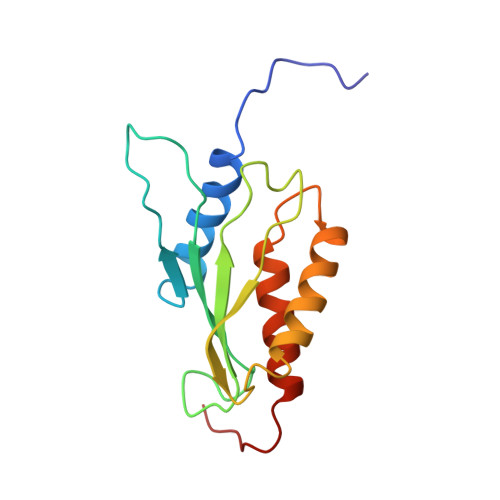
Top ▲

 target has curated data in GtoImmuPdb
target has curated data in GtoImmuPdb
Target id: 2018
Nomenclature: eukaryotic translation initiation factor 2 alpha kinase 4
Abbreviated Name: GCN2
Family: GCN2 subfamily
Gene and Protein Information  |
||||||
| Species | TM | AA | Chromosomal Location | Gene Symbol | Gene Name | Reference |
| Human | - | 1649 | 15q15.1 | EIF2AK4 | eukaryotic translation initiation factor 2 alpha kinase 4 | |
| Mouse | - | 1648 | 2 E5 | Eif2ak4 | eukaryotic translation initiation factor 2 alpha kinase 4 | |
| Rat | - | 1649 | 3 q35 | Eif2ak4 | eukaryotic translation initiation factor 2 alpha kinase 4 | |
Previous and Unofficial Names  |
| GCN2 |
Database Links  |
|
| Alphafold | Q9P2K8 (Hs), Q9QZ05 (Mm) |
| BRENDA | 2.7.11.1 |
| CATH/Gene3D | 3.10.110.10, 3.40.50.800 |
| ChEMBL Target | CHEMBL5358 (Hs) |
| Ensembl Gene | ENSG00000128829 (Hs), ENSMUSG00000005102 (Mm), ENSRNOG00000006027 (Rn) |
| Entrez Gene | 440275 (Hs), 27103 (Mm), 114859 (Rn) |
| Human Protein Atlas | ENSG00000128829 (Hs) |
| KEGG Enzyme | 2.7.11.1 |
| KEGG Gene | hsa:440275 (Hs), mmu:27103 (Mm), rno:114859 (Rn) |
| OMIM | 609280 (Hs) |
| Pharos | Q9P2K8 (Hs) |
| RefSeq Nucleotide | NM_001013703 (Hs), NM_013719 (Mm), NM_001105744 (Rn) |
| RefSeq Protein | NP_001013725 (Hs), NP_038747 (Mm), NP_001099214 (Rn) |
| UniProtKB | Q9P2K8 (Hs), Q9QZ05 (Mm) |
| Wikipedia | EIF2AK4 (Hs) |
Selected 3D Structures  |
|||||||||||

|
|
||||||||||
Enzyme Reaction  |
||||
|
||||
Download all structure-activity data for this target as a CSV file 
| Inhibitors | |||||||||||||||||||||||||||||||||||||||||||||||||||||||||||||||||||||||||||||||||||
| Key to terms and symbols | View all chemical structures | Click column headers to sort | |||||||||||||||||||||||||||||||||||||||||||||||||||||||||||||||||||||||||||||||||
|
|||||||||||||||||||||||||||||||||||||||||||||||||||||||||||||||||||||||||||||||||||
DiscoveRx KINOMEscan® screen  |
|||||||||||||||||||||||||||||||||||||||||||||||||||||||||||||||||||||||||||||||||||||||||||||||||||||||||||||||||||||||||||||||||||||||||||||||||||||||||||||||||||||||
|
A screen of 72 inhibitors against 456 human kinases. Quantitative data were derived using DiscoveRx KINOMEscan® platform. http://www.discoverx.com/services/drug-discovery-development-services/kinase-profiling/kinomescan Reference: 2,6 |
 
|
||||||||||||||||||||||||||||||||||||||||||||||||||||||||||||||||||||||||||||||||||||||||||||||||||||||||||||||||||||||||||||||||||||||||||||||||||||||||||||||||||||||
| Key to terms and symbols | Click column headers to sort | ||||||||||||||||||||||||||||||||||||||||||||||||||||||||||||||||||||||||||||||||||||||||||||||||||||||||||||||||||||||||||||||||||||||||||||||||||||||||||||||||||||||
| Target used in screen: GCN2(Kin.Dom.2,S808G) | |||||||||||||||||||||||||||||||||||||||||||||||||||||||||||||||||||||||||||||||||||||||||||||||||||||||||||||||||||||||||||||||||||||||||||||||||||||||||||||||||||||||
|---|---|---|---|---|---|---|---|---|---|---|---|---|---|---|---|---|---|---|---|---|---|---|---|---|---|---|---|---|---|---|---|---|---|---|---|---|---|---|---|---|---|---|---|---|---|---|---|---|---|---|---|---|---|---|---|---|---|---|---|---|---|---|---|---|---|---|---|---|---|---|---|---|---|---|---|---|---|---|---|---|---|---|---|---|---|---|---|---|---|---|---|---|---|---|---|---|---|---|---|---|---|---|---|---|---|---|---|---|---|---|---|---|---|---|---|---|---|---|---|---|---|---|---|---|---|---|---|---|---|---|---|---|---|---|---|---|---|---|---|---|---|---|---|---|---|---|---|---|---|---|---|---|---|---|---|---|---|---|---|---|---|---|---|---|---|---|---|
|
|||||||||||||||||||||||||||||||||||||||||||||||||||||||||||||||||||||||||||||||||||||||||||||||||||||||||||||||||||||||||||||||||||||||||||||||||||||||||||||||||||||||
| Displaying the top 10 most potent ligands View all ligands in screen » | |||||||||||||||||||||||||||||||||||||||||||||||||||||||||||||||||||||||||||||||||||||||||||||||||||||||||||||||||||||||||||||||||||||||||||||||||||||||||||||||||||||||
| Immunopharmacology Comments |
| GCN2 is a so-called 'stress kinase'. It phosphorylates serine 51 on the global transcription factor eIF2α upon activation by uncharged tRNA; tRNAs accumulate when amino acid levels are depleted. Phospho-eIF2α blocks translation to cause proliferative arrest. GCN2 plays several roles in the immune system. It is required for dendritic cell activation and antigen presentation. The GCN2 stress response is required for both optimal proliferation of CD8+ T cells after antigen stimulation, and trafficking to lymphoid organs, i.e. for normal cytotoxic T cell function [5]. GCN2 is dispensable for CD4+ cell proliferation. |
| Immuno Process Associations | ||
|
||
|
||
|
||
|
||
|
Clinically-Relevant Mutations and Pathophysiology 
|
||||||||||||||
|
||||||||||||||
1. Brazeau JF, Rosse G. (2014) Triazolo[4,5-d]pyrimidine Derivatives as Inhibitors of GCN2. ACS Med Chem Lett, 5 (4): 282-3. [PMID:24900825]
2. Davis MI, Hunt JP, Herrgard S, Ciceri P, Wodicka LM, Pallares G, Hocker M, Treiber DK, Zarrinkar PP. (2011) Comprehensive analysis of kinase inhibitor selectivity. Nat Biotechnol, 29 (11): 1046-51. [PMID:22037378]
3. Jackson JJ, Shibuya GM, Ravishankar B, Adusumilli L, Bradford D, Brockstedt DG, Bucher C, Bui M, Cho C, Colas C et al.. (2022) Potent GCN2 Inhibitor Capable of Reversing MDSC-Driven T Cell Suppression Demonstrates In Vivo Efficacy as a Single Agent and in Combination with Anti-Angiogenesis Therapy. J Med Chem, 65 (19): 12895-12924. [PMID:36127295]
4. Nameki N, Yoneyama M, Koshiba S, Tochio N, Inoue M, Seki E, Matsuda T, Tomo Y, Harada T, Saito K et al.. (2004) Solution structure of the RWD domain of the mouse GCN2 protein. Protein Sci, 13 (8): 2089-100. [PMID:15273307]
5. Van de Velde LA, Guo XJ, Barbaric L, Smith AM, Oguin 3rd TH, Thomas PG, Murray PJ. (2016) Stress Kinase GCN2 Controls the Proliferative Fitness and Trafficking of Cytotoxic T Cells Independent of Environmental Amino Acid Sensing. Cell Rep, 17 (9): 2247-2258. [PMID:27880901]
6. Wodicka LM, Ciceri P, Davis MI, Hunt JP, Floyd M, Salerno S, Hua XH, Ford JM, Armstrong RC, Zarrinkar PP et al.. (2010) Activation state-dependent binding of small molecule kinase inhibitors: structural insights from biochemistry. Chem Biol, 17 (11): 1241-9. [PMID:21095574]
GCN2 subfamily: eukaryotic translation initiation factor 2 alpha kinase 4. Last modified on 31/10/2022. Accessed on 23/04/2024. IUPHAR/BPS Guide to PHARMACOLOGY, https://www.guidetopharmacology.org/GRAC/ObjectDisplayForward?objectId=2018.